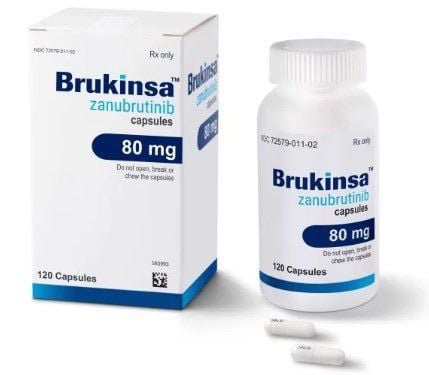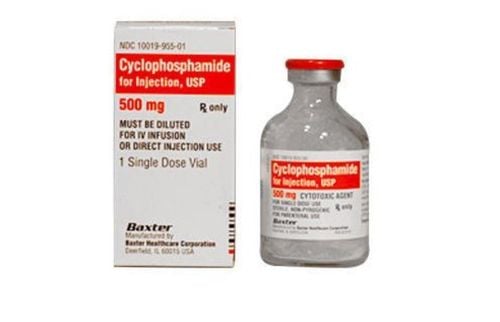This is an automatically translated article.
Brukinsa drug has the active ingredient zanubrutinib, which is a drug used in the treatment of neuroblastoma very effectively. Breyanzi is currently licensed for use in many countries around the world.
1. What are the effects of Brukinsa?
Zanubrutinib is the main active ingredient of the drug Brukinsa. The drug is essentially an inhibitor of Kinase - an enzyme that promotes cell growth. There are many types of kinases in the body that help control different stages of cell growth. By blocking a specific enzyme, Brukinsa can slow the growth of cancer cells.
2. Instructions for using Brukinsa
Brukinsa is in the form of capsules, to be taken orally and should be swallowed whole with a glass of water. Brukinsa capsules must not be broken, opened or chewed, and may be taken with or without food. If the patient misses their dose of Brukinsa, take the next dose of Brukinsa as soon as they remember and then return to their normal schedule the next day.
Brukinsa blood levels can be affected by a number of foods and drugs, so Brukinsa should be avoided with: Itraconazole, Voriconazole, Posaconazole, Fluconazole, Isavuconazole, Clarithromycin, Diltiazem, Erythromycin, Rifampin and Omeprazole. The dose of Brukinsa may be reduced if the patient is taking certain other medicines.
Brukinsa can also cause hepatitis B reactivation in patients who have had previous hepatitis. Make sure the doctor is aware of the patient's previous diagnosis and treatment of hepatitis B. Patients can also be given medicine to prevent Herpes simplex virus and Jiroveci pneumonia.
3. How to store Brukinsa?
Store Brukinsa in its original, labeled packaging, at room temperature and in a dry place and out of reach of children and pets.
If caregivers are preparing a dose of Brukinsa for a patient, they should consider wearing gloves or pouring the medication directly from the container into the lid, cup, or directly into the patient's hand, avoiding touching the Brukinsa tablet. Always wash your hands before and after administering Brukinsa to a patient. Pregnant or nursing women should not prepare doses of Brukinsa for patients. Do not flush Brukinsa down the toilet or throw it in the trash.
4. Possible side effects of Brukinsa
Patients can apply a number of different measures to control the side effects of Brukinsa for each specific patient. The following are some of the most common or important side effects of Brukinsa:
4.1. Infection, low white blood cell count Brukinsa can cause life-threatening infections, with or without a decrease in white blood cells. Your doctor may prescribe medication to prevent certain infections from developing related to Brukinsa treatment.
White blood cells have a role in fighting infection-causing agents for the body, but during treatment with Brukinsa, the white blood cell count may decrease, leading to an increased risk of infection. It is important that patients taking Brukinsa tell their doctor or nurse immediately if they have any signs of an infection such as: fever over 38 degrees, sore throat, cold, trouble breathing, cough, painful urination or slow-healing sores. Some recommendations of doctors to limit infection while taking Brukinsa:
Wash your hands often, including patients, relatives or visitors. Limit going to crowded places, contact with people showing signs of infection. Do not handle pet waste while being treated with Brukinsa. Maintain hygiene at open wounds or scratches. Shower, clean body, teeth regularly. Do not take corners, cut fingernails/toenails too deep. Talk to your oncologist before having a dental procedure while you're taking Brukinsa. Consult your doctor before receiving any vaccine while taking Brukinsa . 4.2. Thrombocytopenia Platelets are part of the blood clotting process, when a low platelet count increases the risk of bleeding, patients taking Brukinsa should tell their doctor if bruising or bleeding occurs. Abnormal bleeding (nose or tooth bleeding, bloody urine, etc.). Platelet transfusion is necessary if the platelet count falls too low while taking Brukinsa. In addition, patients should also avoid some activities that can cause bleeding during treatment with Brukinsa as follows:
Limit or avoid the use of razors. Avoid contact sports, which can cause injury or bleeding. Do not take Brukinsa with Aspirin or non-steroidal anti-inflammatory drugs (NSAIDs). Do not use dental floss or toothpicks due to the risk of bleeding. Do not brush your teeth with a brush with very stiff bristles. In rare cases, Brukinsa can cause severe bleeding, also known as hemorrhagic diathesis. Patients should contact their doctor immediately if there is any bleeding, a change in speech, or a headache that does not go away. If surgery is scheduled, the patient may need to stop taking Brukinsa for a period of time.
4.3. Low red blood cell count, anemia Red blood cells are responsible for carrying oxygen to the tissues in the body, when a low red blood cell count can make a patient feel tired or weak. If the count is too low, the patient can receive a blood transfusion.
4.4. Rash Some patients may develop a rash while taking Brukinsa . Then use an alcohol-free moisturizer on your skin and lips, and avoid moisturizers with fragrances or fragrances. If the patient's skin is cracked or bleeding, be sure to keep the area clean to prevent infection. Any rash that develops should be informed to your oncologist, as this could be a reaction. Brukinsa drug allergy.
4.5. Diarrhea Diarrhea is a possible side effect of Brukinsa that can lead to dehydration, and your doctor may prescribe certain medications to control this. In addition, the patient can apply some measures such as:
Limit high-fiber foods, so eat bland; Avoid eating raw fruits, raw vegetables, whole grain breads, cereals, nuts. Use foods with soluble fiber such as ripe bananas, boiled potatoes, chips, white flour products or oatmeal. Drink enough water and limit alcohol or caffeine to prevent dehydration. 4.6. Less common but important side effects of Brukinsa Heart problems: Brukinsa may cause a fast or irregular heartbeat or an irregular heartbeat, atrial fibrillation, or atrial flutter. Notify the doctor immediately if the patient feels an irregular heartbeat or develops dizziness, lightheadedness, or fainting. Pain, muscle or joint pain: Your doctor may recommend medications and other strategies to help relieve pain. Secondary cancer: A disease that develops after treatment for another cancer, this is quite rare, but patients should still take all risks. This cancer can occur many years after treatment, often related to repeated treatment or high doses of treatment drugs. Consider a complete blood count while on high-risk therapies. There is very little risk of developing non-melanoma skin cancer from treatment with Brukinsa, which can occur many years after treatment. Brukinsa has been linked to the development of skin cancer, so it's important to avoid the sun between 10-2pm, wear sunscreen (SPF at least 15) daily, and wear sunglasses. .
5. Reproductive health concerns when using Brukinsa
Exposure of the fetus to Brukinsa can cause birth defects, so patients should not become pregnant or fathering while taking Brukinsa. Effective birth control is needed during treatment with Brukinsa and for at least 1 week after the last dose of Brukinsa for both women and men. Breastfeeding is not recommended while taking Brukinsa or for 2 weeks after the last dose.
Please dial HOTLINE for more information or register for an appointment HERE. Download MyVinmec app to make appointments faster and to manage your bookings easily.













